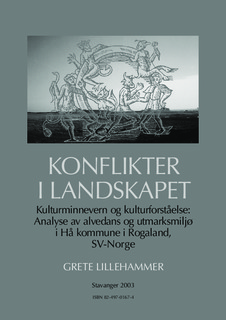| dc.contributor.author | Lillehammer, Grete | |
| dc.date.accessioned | 2011-11-09T07:57:31Z | |
| dc.date.available | 2011-11-09T07:57:31Z | |
| dc.date.issued | 2003 | |
| dc.identifier.citation | Lillehammer, Grete (2003): Konflikter i landskapet: Kulturminnevern og kulturforståelse: Analyse av alvedans og utmarksmiljø i Hå kommune i Rogaland, SV-Norge. Arkeologisk museum i Stavanger. | no_NO |
| dc.identifier.isbn | 82-7760-109-3 | |
| dc.identifier.issn | 0332-6306 | |
| dc.identifier.uri | http://hdl.handle.net/11250/181480 | |
| dc.description | Også en del levert som forfatterens avhandling (dr. art.)- Universitetet i Bergen, 2004 | |
| dc.description.abstract | The work is a theoretical and empirical study of how the management of the cultural heritage is perceived by different interest groups in the society. It represents a new approach which has been little dealt with within heritage research and where the theoretical basis is weakly grounded. The study is limited to a district on Jæren, SW-Norway, where agricultural land use is in conflict with much of the cultural heritage and landscape. The investigation includes an interdisciplinary study between archaeology and palynology of a specific category of mysterious earthworks – the so-called ‘fairy rings’ – and the environment surrounding them. The ‘fairy rings’ represent a category of ancient monument specific to this rural district. It is non-distinct in the environment and on the surface, for preservation purposes a vulnerable type of cultural heritage which often goes unnoticed and is cleared away unintentionally or illegally by farming activities.
The overall object of the study is to gain a wider understanding of the cultural perceptions and public attitudes towards the cultural heritage in the rural district. Firstly, by increasing the knowledge of the age, function and context of the earthworks in relation to the question of continuity-discontinuity of the past in the present. Secondly, by exploring how this knowledge influences the environmental management regimes of the landscape, i.e. the environmental bureaucrats and the farmers. The hypothesis is that the earthworks represent a cultural context which designates a ‘non-place’ in the landscape, i.e. a place which has lost any historical significance in the present. The theoretical approach of the analysis allows the researcher to practise phenomenology by focusing on the phenomena which characterise the heritage and landscape management as perceived by them as an outsider. It directs the analysis towards an emphasis on the ethical aspects involved in conflicts between clashing interests.
The study reveals new and underlying aspects by throwing light upon those interests which are common and those which distinguish the managers from each other in relation to the general conflicts which dominate the historical gap between agricultural and heritage management. The interdisciplinary investigation reveals the earthworks to be the bases for haystacks in the marginal land of out-fields dating between the end of the Early Iron Age (cal. AD 410-450) and AD1835-ca.1970), thus representing a long duration of use and continuity in the landscape. A gap in the perception of the landscape exists between the two professions of managers. A transformation, earlier into supra-natural places of a mythical landscape, later into a ‘non-place’, has been going on since the stacking of hay fell out of use by the local farmers from the 19 th century onwards. The results show the two groups of managers to have different attitudes towards the landscape. Their perspective differs backwards and forwards in time, in their choice of value and in their perception of the landscape. A strategy is presented which offers a way of dealing with present-day conflicts. | no_NO |
| dc.language.iso | nob | no_NO |
| dc.publisher | Arkeologisk museum i Stavanger | no_NO |
| dc.relation.ispartofseries | AmS-Varia; 42 | |
| dc.relation.uri | http://am.uis.no/publikasjoner/AmS-varia/article14014-5016.html | |
| dc.subject | kulturforståelse | no_NO |
| dc.subject | kulturkonflikt | no_NO |
| dc.subject | fenomenologi | no_NO |
| dc.subject | kulturminnevern | no_NO |
| dc.subject | Jæren | |
| dc.title | Konflikter i landskapet: Kulturminnevern og kulturforståelse: Analyse av alvedans og utmarksmiljø i Hå kommune i Rogaland, SV-Norge | no_NO |
| dc.type | Book | |
| dc.subject.nsi | VDP::Social science: 200::Urbanism and physical planning: 230::Landscape planning: 236 | no_NO |
| dc.subject.nsi | VDP::Humanities: 000::Archeology: 090::Nordic archeology: 091 | no_NO |
| dc.source.pagenumber | 283 | |
